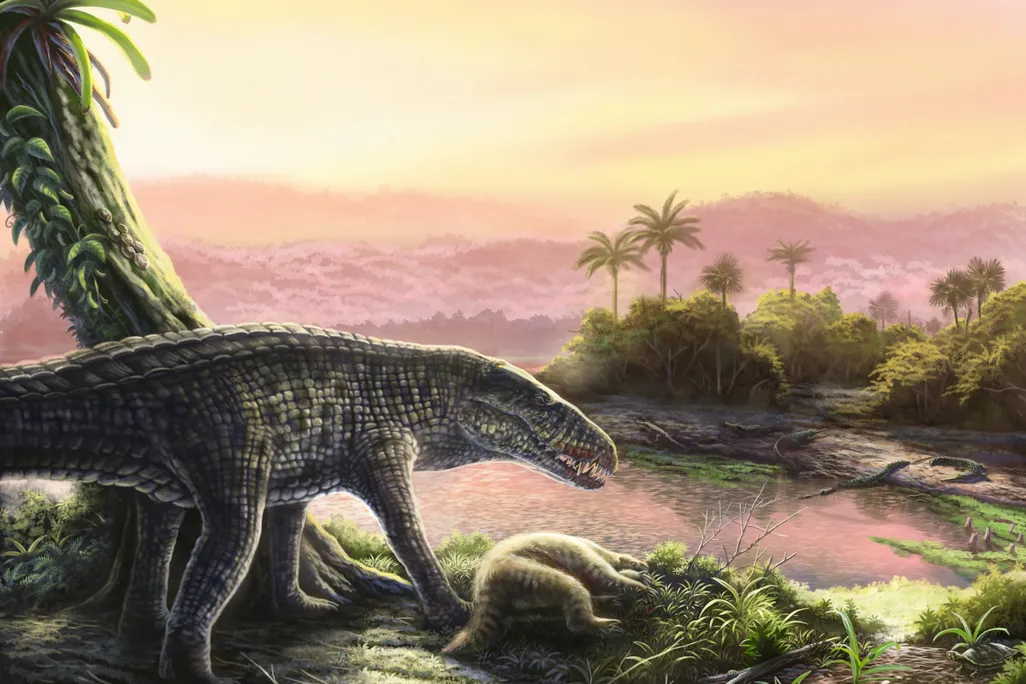WWW.SMITHSONIANMAG.COM
Fossils Reveal Enormous, Crocodile-Like Reptiles Survived for Millions of Years Longer Than Previously Thought
Fossils Reveal Enormous, Crocodile-Like Reptiles Survived for Millions of Years Longer Than Previously Thought
New discoveries in the Dominican Republic suggest sebecids roamed the Caribbean as recently as 4.5 million years ago, long after they vanished from South America
Lillian Ali
- Staff Contributor
May 6, 2025 11:33 a.m.
Crocodile-like sebecids were known to roam South America after dinosaurs went extinct. Recently found fossils suggest they inhabited the Caribbean as well—and thrived there long after they disappeared on the continent.
Jorge Machuky / Florida Museum of Natural History
After dinosaurs went extinct, South America was dominated by large, crocodile-like reptiles called sebecids. Measuring up to 20 feet in length and bearing rows of sharp, serrated teeth, sebecids roamed the continent before disappearing from its fossil record around 11 million years ago.
But over the past 30 years, other fossil finds have offered hints that this story is more complicated. Serrated teeth have appeared at sites on Caribbean islands, including Cuba and Puerto Rico. While those remains suggested that sebecids inhabited the Caribbean, without more fossils, researchers could not confirm whether those teeth were from sebecids or similar reptiles.
But in 2023, paleontologists from the University of Florida found two fossil vertebrae along with another tooth in the Dominican Republic. These vertebrae were flat, like those of sebecids, rather than having the ball-and-socket joints of other crocodile relatives. The researchers’ findings, published last week in
“The vertebrae are the thing that really brings home that they’re sebecids,” lead author Lazaro Viñola-López, a paleontologist at the University of Florida, tells Science News’ Jake Buehler.
The fossils found by Viñola-López’s team suggest not only that sebecids made their way to the Caribbean, but that those lineages held out longer than their counterparts in South America. While the most recent sebecid fossils found in South America date to between 10.5 million and 12.5 million years ago, the tooth and vertebrae found in the Dominican Republic date to as recently as 4.5 million years ago, pointing to Caribbean islands as the last stronghold for the enormous reptiles.
“You wouldn’t have been able to predict this looking at the modern ecosystem,” University of Florida paleontologist Jonathan Bloch, senior author of the paper, tells the Florida Museum’s Brooke Bowser in a statement. “The presence of a large predator is really different than what we imagined before, and it’s exciting to think about what might be discovered next in the Caribbean fossil record as we explore further back in time.”
The research team found this fossil of another prehistoric crocodilian in the Dominican Republic.
Jonathan Bloch / Florida Museum of Natural History
The dinosaur age ended 66 million years ago with a catastrophic asteroid impact, leading to the rapid extinction of non-avian dinosaurs. In their place, mammals began to dominate the land. But sebecids, which survived the mass extinction of dinosaurs, stayed on top of the food chain in South America, ruling the continent for tens of millions of years. They had narrow, dinosaur-like skulls and long legs that made them capable of chasing down prey. Bony plates embedded in their skin offered sebecids a protective armor.
“These were the types of predators that one thinks were from dinosaur times,” Viñola-López tells Reuters’ Will Dunham.
Sebecids were the last surviving notosuchians, crocodile-like reptiles that first appeared in the Jurassic Period. Notosuchians varied in size, diet and habitat, but unlike modern crocodiles, they lived mostly on land. The fossil discoveries are part of “a glorious record extending back the whole Age of Dinosaurs into the Cenozoic,” as Bloch tells Science News. The Cenozoic era is Earth’s current geological era, starting 66 million years ago and continuing today.
Sebecids resemble crocodiles, but their long limbs would have made them land hunters—and rendered them unable to swim from South America to islands in the Caribbean. Instead, researchers hypothesize, the reptiles might have traversed the sea on rafts of vegetation or crossed pathways of temporary land bridges.
“I really am sorry they’re gone, because they must have been totally awesome to see,” Christopher Brochu, a paleontologist at the University of Iowa who was not involved in the study, tells Science News.
Get the latest stories in your inbox every weekday.
